
Instruction
2
Important instructions concerning technical safety and personal protection are, as shown below, especially
highlighted.
Danger:
This refers to working and operating procedures which must be complied with in order to rule out
the risk to persons.
Caution:
This refers to working and operating procedures which must be complied with in order to prevent
damage to or destruction of material.
Note:
Explanatory descriptions which help in understanding the relevant work or operating procedure to
be carried out.
Fitting flat seals / gaskets
Gaskets are frequently used with sealants or adhesives as an aid to assembly or to achieve a better seal.
Above all when parts with different levels of thermal expansion (e.g. aluminium and cast iron) are bonded,
this can mean that the gasket is shifted during operation by the so-called stitching or sewing machine effect
and leaks occur.
Example:
The cap of the front crankshaft seal. If a sealing agent or an adhesive is used here the flat seal
will move inwards in the course of time as a result of the different expansion rates of the materials. Oil will
be lost, for which the shaft seal may be thought to be responsible.
Perfect assembly of gaskets can only be achieved if the following instructions are adhered to:
D
Use only genuine MAN seals / gaskets.
D
The sealing faces must be undamaged and clean.
D
Do not use any sealing agent or adhesive
−
as an aid to fitting the seals a little grease can be used if
necessary so that the seal will stick to the part to be fitted.
D
Tighten bolts evenly to the specified torque.
Assembly of round sealing rings
D
Use only genuine MAN round sealing rings.
D
The sealing faces must be undamaged and clean.
D
Always wet round sealing rings with engine oil before fitting them.


































